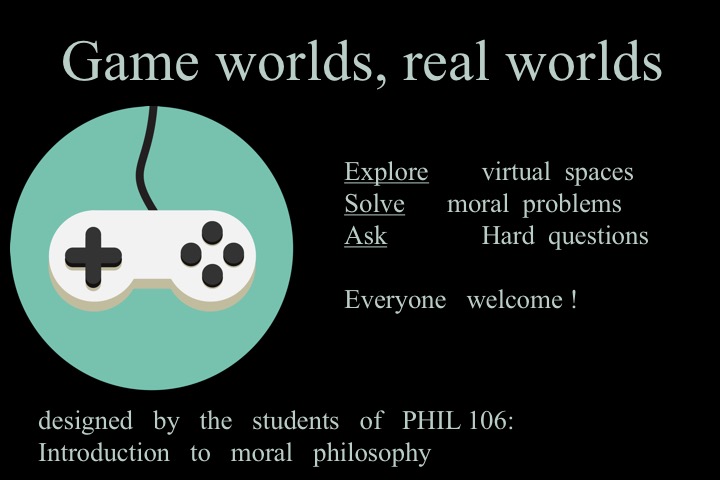Introduction to Moral Philosophy
Introduction to Moral Philosophy
PHIL 106 • Julie Walsh

The class used this image to promote the mini-conference where students showcased their games to their peers and other members of the faculty and college.
I incorporated a blended learning element in to my PHIL 106 (Introduction to Moral Philosophy) course. This course centers on introducing students to moral theory, as well as how that theory can be applied to contemporary difficult moral questions. In Spring 2016, I included a unit of the course that treated virtual environments and two ethical questions that I see as two faces of the same coin: (1) Do virtual acts have moral status? (2) Can virtual worlds (that is, video games, virtual reality environments, etc.) help us grapple with moral questions? In order to engage with (1), we read recent articles devoted to exploring this topic. In order to engage with (2), we had have a two-pronged strategy. First, in connection with an installation planned for April 2016 at the Davis Museum, curated by Mike Maizels (Mellon New Media Curator and postdoctoral fellow), the students explored several video games by the game designer Jason Rohrer. Rohrer is known for his thought provoking and ethically ambiguous games. Playing the games that will be available through the installation at the Davis encouraged the students to think about the moral value of exploring a virtual environment and acting therein. The second prong involved blended learning: using the open source software Twine, working in groups, students designed their own video games that involve a moral lesson/component/question.
The pedagogical goal was to encourage students to think about the connection between ethics and virtual spaces, and to allow them to use more creative means of commenting on a philosophical issue. This introduced a meaningful shift away from traditional models of evaluation in philosophy courses, which are often exclusively writing-based. As a result, different environments for learning were emphasized (the Davis and the computer lab!) and showed students that philosophical questions can (and perhaps even ought to) be engaged outside of this traditional model. This kind of assignment also encouraged students to think about philosophical questions “from the other side.” Following the traditional model, student essays are intended to demonstrate their understanding of the course material. By designing a basic game that is intended to guide a user through a moral question or problem, students are using their skills to teach their understanding of the course material.
The games that the students design were destined to have a life outside of the classroom. We held a mini-conference at Clapp library, where the students showcased their games to their peers, and other members of the faculty and college. Even Jason Rohrer stopped by (which was very exciting).
The students reported really enjoying this element of our course, and even some students who are not fans of group work indicated that even they enjoyed the group element! I think that the assignment was challenging, but also fun. Seeing the kinds of games that the groups produced also allowed me to see a bit more clearly how much of the ethical theories they had deeply understood.
You can explore the project website at http://philome.la/philgames106


